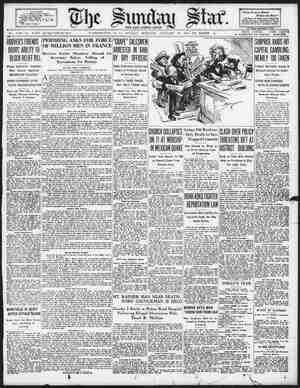Evening Star Newspaper, January 18, 1931, Page 78
You have reached the hourly page view limit. Unlock higher limit to our entire archive!
Subscribers enjoy higher page view limit, downloads, and exclusive features.
Fé6 THE SUNDAY STAR, WASHINGTON, D. C, JANUARY 18 193%. TESTING BABY’'S BRAIN POWER How Science Has Found Unique Ways of Learning What Goes on Inside a Child’s Head Even Though the Infant May Be Too Young to Talk. BY ELIZABETH SPENCE. HAT are baby’s secret thoughts? Actually babies understand what is said long before they are able to speak, psychologists have discovered. Wherefore, parents are respectfully reminded to think be- fore they talk in front of even very young infants, and to count 10 or 110 before indulg- ing in a family tiff while the baby looks on. It is a mistake to assume that the young child does not think or feel, merely because he does not speak. “Blissful as a babe” may not be so hlissful as commonly supposed, some of the riodern evidence shows. If the babe in mind hap- ‘pens to be less than a month old, the chances are especially against his being a really eon- tented creature, for the moment, Prof. Charlotte Buhler concludes from her studies of children in the clinic of the University of Vienna. From a detailed study of all the haby's actions, day and night, she has become ocon- vinced that the predominating feelings dure ing the first month of life are discomfort or fear. She based her comclusions on the things the baby turned toward as if to reach and the things it turned away from as if to avoid. Food appeared to be the only solace of the very young child, whereas he found a variety of things strange and frightening. That a child of less than a year may even have troubles which he tries to hide was in- dicated by another experiment. The infant apparently represses his emotion so as not to be a “cry baby.” Evidence to this effect was obtained by Dr. Harold Ellis Jenes in the In- stitute of Child Welfare at the University of California by means of a delicate instrument, the D’Arsonval galvanometer. Experiments with adults have shown that the electrical conductivity of the skin changes during the stress of emotion, even when the face betrays no sign and nervous movements of the body are controlled. By recording these changes in the skin, the D’Arsonval galvanometer detects outwardly controlled emotion. [ 5 i ieat #e sd5ike if a clue to baby thoughts is to be The custom of ancient times was e overlook the baby’s thoughts entirely ceive of his mind being as blank as B ing eyes, and that wise silence, OME of the pictures of the reveal this habit of thinking little men and women. How ' sometimes world-weary the painted centuries gone by appear! And dimensions of these antique baby measured, they "are often diseo painted like little midgets, with the mature and elongated proportions of adulthood instead of the chubby, shortened contours of babyhvod. The artists have simply overlooked the fact that babies, even baby saints and emperors, differ from grown-ups in other respects than size. Modern methods of fact-seeking and seeing recognize important differences between child and adult. New measuvements and records are At two months baby stares solemnly back at person caring for him. At three months baby smiles and his in- telligence begins to dawn. At four months his eyes follow an object. At old continuously during 24-hour periods. At el domes. like structures made with fine white wire When placed over the infant’s ¢rib, these domes allow free circulation of air. 'HEY enable observers to watch without be- ing noticed by the child. Cameras moving at seven between are achievements at 6 months., Showing dis- pleasure at unsuccessful grasping and imitating characteristics it '*!:l!:' 3 g e months he for an obj At '.mauluhcu't without rt:zn 2 t‘pet. six s up supporly At eight months baby chooses the he wants. Acninamoullulwcu?;i,: tinguish people, speaks first words. As 10 months he stands without su, and at 11 months he raises hi f so get an object overhead.
